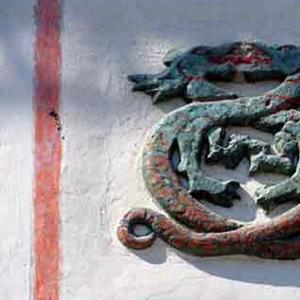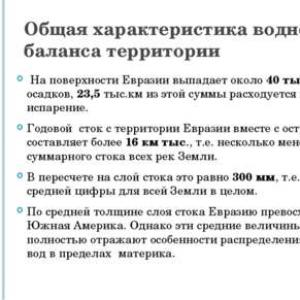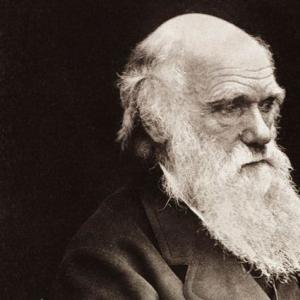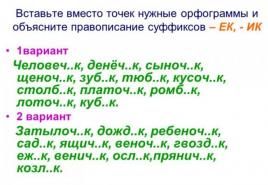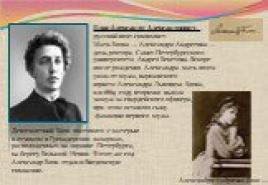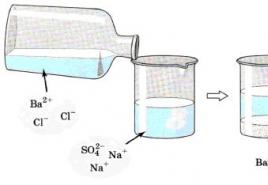Prepare a message about the Crimean Khanate. Presentation on the Crimean Khanate Presentation on the history of the Crimean Khanate
Bakhchisarai is the ancient residence of the Crimean khans Gireys, who ruled the khanate for over 300 years (1434 - 1783). Translated from the Turkic name of the city means "palace in the gardens."
The main attractions of Bakhchisarai are: the former Khan's palace (now the Bakhchisarai historical, cultural and archaeological museum-reserve); the largest Orthodox Uspensky monastery in Crimea and the "cave city" Chufut-Kale.
In Bakhchisarai, not only the palace reminds of the Crimean Khanate, but also old madrasahs, narrow streets that still retain the flavor of a medieval eastern city.
The population of Bakhchisarai is about 30 thousand people, together with the municipal district - about 100 thousand people. The city emerged from the valley into the plain, where its new districts were spread.
Bakhchisarai is fanned by poetry, praised by Pushkin in the poem "The Fountain of Bakhchisarai":
Leaving the north at last
Forgetting feasts for a long time
I visited Bakhchisarai
In oblivion, a slumbering palace.
Among the silent transitions
I wandered where the scourge of the peoples
The Tartar feasted violently,
And after the horrors of the raid
I was drowning in luxurious laziness.
The foundation of Bakhchisarai
Bakhchisarai is located in the valley of the Churuk-Su river (Turkic "rotten water"), which is a tributary of the river. Kacha.
 An old legend about the son of Khan Mengli-Girey, who watched the battle of snakes on the bank of Churuk-Su, is associated with the creation of Bakhchisarai. The image of two snakes above the entrance to the Khan's palace reminds of this old legend today.
An old legend about the son of Khan Mengli-Girey, who watched the battle of snakes on the bank of Churuk-Su, is associated with the creation of Bakhchisarai. The image of two snakes above the entrance to the Khan's palace reminds of this old legend today.
The city arose at the beginning of the 16th century as the capital of the Crimean Khanate. Built in a narrow valley. And today it has retained the flavor of the medieval city, as if hidden between steep rocks. In the last decade, the city has grown, went beyond the narrow valley into the plain. Its new districts are spread here. The administrative center of Bakhchisarai is Lenin Square.
Development of Bakhchisarai
The development of Bakhchisarai largely depends on the largest enterprise in the city - CJSC Bakhchisarai Combine Stroyindustriya (develops marls).
 The history of the creation of the Bakhchisarai cement plant is as follows: in the late 1950s, new vineyards were laid in Crimea on large areas, new buildings and livestock farms were built.
The history of the creation of the Bakhchisarai cement plant is as follows: in the late 1950s, new vineyards were laid in Crimea on large areas, new buildings and livestock farms were built.
The construction of these structures required a large amount of cement. To meet the needs of the regional farms in 1959, a decision was made to build an inter-collective farm cement plant. In 1996, the legal status of the plant changed; In 2000, it was privatized and reorganized into CJSC Bakhchisaray Combine Stroyindustriya.
Bakhchisarai during the Crimean Khanate
The oldest street in the city is the street leading to the Bakhchisarai Palace. Let's try to imagine what it looked like 500 years ago.
... The traveler barely pushes his way along the only street that leads to the palace ... It is so narrow that two carriages can hardly part. Tatar mazhars with coals and wood pass by with an incredible creak. Every resident of the city knows about their departure.
Stalls with variegated goods and climb on top of each other. Lamb carcasses touch the golden fez. The only street in Bakhchisarai is the arsenal of the Crimean Khanate. There are arms shops under the canopy. The traveler is deafened by the clink of copper, polished iron, the rumble of forges, and the cough of camels.
Silence reigns in coffee shops. Tatars, those who are doing well, sit for hours on mats, legs crossed, or recline to an ancient custom. In front of them is coffee and smoking pipes. Five times a day, the main street is filled with the shout of a muezzin, a Muslim priest calling for prayer - namaz.
There are only men on the street; women in a Tatar family are exclusively engaged in children and housework. If, for some urgent need, a woman had to go out into the street, then she covered her head with a white veil. All that was visible were the lively black eyes and the tips of pointed shoes.
Cultural life in Bakhchisarai
Women did not have the right to sit down with men, talk to strangers. They had no right to learn to write, otherwise they would have been possessed by genies - evil spirits. They could only learn to read the Koran. They were forbidden to enter the mosque, they can only pray at home.
 The cultural revolution in the life of the Crimean Tatar people was made by the famous Tatar educator Ismail Gasprinsky in the late 19th - early 20th centuries.
The cultural revolution in the life of the Crimean Tatar people was made by the famous Tatar educator Ismail Gasprinsky in the late 19th - early 20th centuries.
He began to publish a newspaper in the city in the Tatar and Russian languages, achieved the opening of a printing house, opened a school, and was also a talented writer.
In 2001, the house where Gasprinsky lived became a museum. In 2004, a monument to the educator was opened. In 1999, to the 200th anniversary of the birth of A.S. Pushkin, in memory of his visit to Bakhchisarai in 1820, a monument was erected.
Similar documents
Conquests of the Ottoman Empire, the fall of Constantinople. Vassals of the Turkish Sultan. State structure of the khanate. Resettlement, life and occupations of the Crimean Tatars, Armenians, Karaites. Features of the culture of the Tatars of the period of the Crimean Khanate (mosques, palaces, temples).
term paper, added 12/21/2014
The history of the Krymsk Khanate is the state of the Krymsk Tatars, which was born from 1441 to 1783. Zdobuttya nezalezhnosti on the ear of the XV century, an alliance with the Ottoman Empire. Russian-Turkish wine. Sovereign organization of the Krimsky Khanate, army and culture.
abstract added 01/02/2013
The origin of life in the Crimean mountains: Neanderthals and Cro-Magnens, Taurus, Elinns and Scythians, Goths, Huns and Mongols. Karasubazar during the Crimean Khanate. The development of crafts: leather, jewelry, blacksmithing. The political history of the Crimean Khanate.
term paper added 03/31/2014
The main factors of Russian-Crimean relations in the second half of the 15th - early 17th centuries Ottoman Empire and its role in shaping the foreign policy of the Crimean Khanate. Factors that determined the anti-Russian orientation of Crimea's foreign policy.
abstract added on 12/30/2014
The aspects of the formation and development of the charitable movement among the Crimean Tatars in the Russian Empire of the late 19th - early 20th centuries are analyzed. Using the experience of participating in the charitable movement in the political processes in the Crimea in 1917-1921.
article added on 12/01/2017
Crimea as a crossroads of world civilizations. Symbols and semantics of the characters of the Tengri pantheon. Traditional Turkic worldview. The Crimean Khanate and the Turkish Sanjak, the formation of the Crimean Tatars, Karaites, Krymchaks with distinctive ethnicity, their rituals.
abstract, added 03/29/2015
The first appearance of the Tatars in the Crimea. The reasons for the weakening of the Golden Horde. Recognition of the Crimea as an independent state in 1479; his material and political position in the world. Conclusion of the Kuchuk-Kainardzhiyskiy peace. Accession of the Crimean Khanate to Russia.
abstract added 12/04/2013
Crimea is the ulus of the Golden Horde. Venice and the possessions of Genoa in the Crimea. Creation of the Crimean Khanate (13-15 centuries). Crimean Khanate - vassal of the Ottoman Port (15th century). Molodino battle of 1572. Muscovy, Ukraine, Lithuania, Poland and Crimea (17th century).
thesis, added 09/06/2010
Influence of the Constantinople Peace Treaty in the development of Russian-Crimean relations with the Ottoman Empire. Analysis of the causes of the Crimean raids. Reasons for the success of the Bakhti-Girey raid. Characteristics of the reasons for the construction of the Tsaritsyn line and analysis of its significance.
abstract added 12/24/2013
The history of the relationship between the Crimean Khanate and the feudal rulers of the North-Eastern Caucasus in the XV-XVIII centuries. The role of Dagestan as a refuge for the disgraced Crimean princes. Involvement of the feudal elites of the Caucasus and Crimea in military-political alliances.
Creation of the Crimean khanate.

1223 The first appearance of the Tatars in Crimea .
- In the early 20s of the XIII century. The Tatar-Mongol army, Jebe and Subedey passed through Northern Iran, Eastern Transcaucasia. In the Kuban region, she defeated the Alans, then the Kipchaks-Polovtsians. In pursuit of them, Jebe and Subedey penetrated into the Crimea, destroyed Surozh, and then defeated the combined Polovtsian and Russian troops in the battle of Kalka.

Second floor. 30s XIII - the first quarter of the 15th century. Crimea as part of the Horde.
- The Tatars' raids on the Crimea were repeated in 1238, 1242, 1249.
- The peninsula became part of the Golden Horde as one of its uluses.
- In the XIV century. Tatars began to distinguish from their midst urban element , concentrated in Solkhat. The Tatars gave him the name Kyrym (Crimea)
- The governors of the Golden Horde khans had their residence in Kyrym.

XIII-XV centuries. Genoese in the Crimea.
- In the middle of the XIII century. the Genoese won a six-year war against the Venetians and until 1475. dominated the Black Sea trade. In the 70s of the X III century. they acquired from the Golden Horde governors the right to establish a trading post in the place where Feodosia had previously existed. This is how the famous Kafa, the center of the Genoese possessions in the Crimea, arose.
- Trade brought great profits to the Genoese, especially the slave trade.
- The Genoese colonies, which paid tribute to the Tatars, were independent in their internal affairs.
- In the XIV-XV centuries. Genoese colonies in the Crimea flourished.
- In 1380. during the battle of the Russians with the Tatars on the Kulikovo field, among the Tatar army of Mamai there were also detachments of the Crimean "fryag" (Italians).

1433-1465 Haji Giray - the founder of the Crimean Khanate.
- As a result of many years of struggle for the peninsula with applicants of other clans, Hadji-Girey in 1443. returned to Crimea and, with the support of the Grand Duke of Lithuania and the Turks, proclaimed the Crimean ulus an independent khanate.

1475 Turks invaded Crimea.
- In 1475. the Turks captured a number of coastal cities and Crimea became part of the Ottoman state. In addition, in strategically important areas of the steppe part of the peninsula, the Turks built fortresses and maintained permanent garrisons in them. They were Or (Perekop), Arabat, Yenikale, Gezlev.

1475-1774. The Crimean Khanate is a vassal of Turkey.
- After their establishment in the Crimea, the Turks retained control of the steppe part of the peninsula in the hands of the Crimean Khan Mengli-Girey. He became a vassal of the Turkish Sultan. He, at his discretion, appointed and removed the khans from the Girey dynasty. ... The Crimean Khanate was autonomous within the Ottoman state.

Territories of the Crimean Khanate.
- Initially, the Khanate included the foothill and steppe Crimea, the eastern part of the Black Sea and the Azov steppes. Then the khans seized the Black Sea towns belonging to the Grand Duchy of Lithuania - Dashev (Ochakov), Khadzhibey (Odessa), Akkerman (Belgorod), etc. As a result of the Tatar raids, the strongholds of the Grand Duchy of Lithuania in the steppe part of Ukraine were destroyed. After the liquidation by Moscow in the middle of the XVI century. Astrakhan Khanate Crimean khans annexed the Kuban region. Since then, the Khanate included a significant part of the North Caucasus, the Azov region and the Northern Black Sea region.

State structure of the Crimean Khanate.
- Khans were appointed by special sultan firmans. The khans were obliged, at the first demand of the sultan, together with their troops to go against any enemy of Turkey.
- The khan's power was limited.
- The khan commanded the troops, minted coins, established duties and imposed taxes on Christians at his discretion.
- There was no standing army in the khanate. Its armed forces consisted of the militia.

National composition
- The Crimean Khanate was multinational. The largest group of its population was the Nogai - nomadic Tatars. In the steppe part of the peninsula, a nomadic way of life prevailed. In the foothill and mountainous parts, the Tatar population led a sedentary lifestyle.
- The proportion of the Christian population - Greeks and Armenians - was also significant. They were engaged in agriculture, handicraft production, trade.
- There were many Turks in the coastal cities.
- Persons of other nationalities also lived on the territory of the khanate.

XV-XVIII centuries, Crimean Khanate and Little Russia (Ukraine).
After the destruction of Kiev by Mengli-Giray in 1482, the Little Russia lands were subjected to annual raids. The Tatars stole many prisoners. To protect against them, the magnates built castles. Peasants entering the field were forced to take guns and sabers with them to protect their lives. At the end of the XV - beginning of the XVI century. In the Little Russian lands, farms and settlements of the Cossacks appeared, who gradually conquered the steppe from the Tatars. arose the Zaporozhye Sich, which played an outstanding role in the national liberation struggle in the 16th-17th centuries. and in protecting him from Tatar raids.
Work performed by: Vychegzhanina Ksenia 7A
Slide 2: Objectives:
Get acquainted with the history of the heirs of the Golden Horde Characterize their political and economic development Determine the peculiarities of the development of their state organization of the Crimean Khanate Reveal the connection between the history of individual regions and the history of the whole country
Slide 3: Objectives:
Compile a glossary of terms Explore and analyze the features of political and economic and cultural development, the social composition of the population Compile a guide to the history of states What significance for the peoples-regions had the mutual influence of their cultures Write an impression about your work and its result
Slide 4: Map of the Crimean Khanate
Slide 5: Crimean Khanate
CRIMEAN KHANATE (1441/1443-1783), a medieval state in the Crimea. Formed on the territory of the Crimean ulus of the Golden Horde during its disintegration. The founder of the Crimean Khanate was Khadzhi-Girey (1441/1443-1466). The boundaries of the Crimean Khanate during the period of its power (mid-15th century) included the territories of the Northern Black Sea region from the mouth of the Dniester in the West to the right bank of the Don in the East, to the Vorskla River in the North.
Slide 6: Crimean Khanate
The Crimean Khanate consisted of four large possessions of the Argyn, Baryn, Kipchak and Shirin clans. The nomadic possessions of Edisan, Budzhak, Malye Nogai depended on the Crimean Khanate. During its heyday, the khanate was divided into beyliks, which united the lands of several settlements and were ruled by representatives of various Tatar clans.
Slide 7: Crimean Khanate
The capital, the city of Bakhchisarai, is a large religious, political and commercial center. There were also other large cities: Solkhat (Iski-Crimea), Kafa, Akkerman, Azak (Azov), Kyrk-Er (Chufut-Kale), Gozlev, Sudak. All of them were the centers of beyliks and the focus of administrative power, crafts, trade, and religious life.
Slide 8: Crimean Khanate
Tatars, Greeks, Armenians, Karaites, Krymchaks lived on the lands of the Crimean Khanate; in the port cities there are also Italian merchants. The nobility called themselves Tatars, sometimes with the addition of "Krymly" (that is, Crimean), and the main population most often defined themselves on the basis of religion - Muslims. The main language in the Crimean Khanate was Turkic, it was also used for office work, diplomatic correspondence and literary creativity; from the 16th century, numerous Ottomanisms began to penetrate into it.
Slide 9: Crimean Khanate
The supreme power in the Crimean Khanate belonged to the khans from the Girey clan, the descendants of Khan Jochi.

10
Slide 10: Crimean Khanate
After the establishment in 1475 of the vassal dependence of the Crimean Khanate from the Turkish Empire, a different system of power was formed here. The real ruler of the Crimea was the Turkish sultan, who had the right to displace and appoint khans, control all international relations of the khanate, and also call on the Crimean troops on a campaign. Formally, the khans of the Crimean Khanate were autocratic monarchs, but in reality their power was limited by the Turkish sultans and ruling clans. Khans sealed all the laws of the country and performed other representative functions. The basis of the khan's wealth was his ulus, located in the valleys of the Alma, Kacha and Salgir rivers.
11
Slide 11: Economy of the Crimean Khanate
The Crimean khans were interested in the development of trade, which gave significant profits to the treasury. A significant role was played by the slave trade and ransoms for the captured in the lands of the Commonwealth and the Russian Kingdom. The main buyer of slaves was the Ottoman Empire.
12
Slide 12: Economy of the Crimean Khanate
Kaffa was a major trade and economic center; the seaport of the city played an important role in this. Thanks to this, the city had extensive trade links.
13
Slide 13: Development of the Crimean Khanate
Founder - Haji Girey Strengthening under Mengle Girey In 1478 they became vassals of the Ottoman Empire Attack on the Great Horde and the Grand Duchy of Lithuania Union with Russian princes
14
Slide 14: Influence of the Crimean Khanate on the whole country
Since the territory of the Crimean Khanate has a very favorable climate and fertile soil for the cultivation and manufacture of certain products, the trade in the Khanate was actively developed.
15
Slide 15: Glossary of terms
Khanate is a state formation or territory ruled by a khan. Beilik is a small feudal possession ruled by the Bey Klan (Gaelic clann - family or offspring) - the name of the clan Ulus - a Mongolian and Turkic social term with complex semantics, serving mainly to denote the concepts of "people, state".
16
Slide 16: Guide
The Crimean Khanate was formed in 1443, the Crimean Peninsula, as well as the lands from the Danube in the west to the Don and Kuban in the east. The Crimean Khanate is a multinational state. It was inhabited by Turkic-speaking peoples (Tatars, Karaites, Turks, Nogais), Greeks, Armenians, Jews. The khanate was headed by the ruling dynasty - Girey. The main activity of the Crimean feudal lords was horse breeding, cattle breeding and the slave trade. Crafts and architecture are developed (mosques, dyurbe) Conclusion: The Crimean Khanate is a fairly strong state, but it ceased to exist because it was annexed by the Russian Empire.
17
Last slide of presentation: Crimean Khanate: General conclusion
The Crimean Khanate is a very interesting state with an entertaining history, I liked studying it
"Crimean War" - Battle of Inkerman Battle of Balaklava. Causes of the Crimean War. What facts impressed you the most? Kornilov Nakhimov Istomin Totleben Pirogov. Heroes. Crimean War 1853-1856. November 1, 1855 Russian troops took Kars in the Transcaucasus. Aggravation of political and economic contradictions in the Middle East and the Balkans between.
"History of the Crimean War" - 1. Contradictions between European countries. Recruitment system for the formation of the army. 2. The desire of Russia to gain a foothold in the Balkans. France. November 18, 1853. Austrian support as gratitude for participating in the suppression of the revolution in 1848. Crimean War 1853-1856 Conclusion. Monument to Peter the Cat.
"Crimean War of 1853" - Terms of the Paris Peace Treaty. In 1863-1877. actually headed the military engineering department. Stage 2. In the besieged Sevastopol. Stage 1. Occasion. Russia and Turkey cannot have a navy and fortifications on the Black Sea. Konstantinovskaya battery of Sevastopol. View of Sevastopol. Kornilov Vladimir Alekseevich (1806-1854).
"Crimean Mountains" - Crimean Mountains. Karst affects the state of water resources. Crimean foothill forest-steppe region covers the Outer and Inner ridges. Summers are hot and dry. Soils - soddy-calcareous on the slopes, chernozem on flat intermontane areas. The amount of precipitation is only 300-600 mm per year, more in autumn and winter.
"Kazakh Khanate" - Kazakh Khanate. Reasons for the formation of the Kazakh Khanate. Tauke khan. Catherine II approved Abylai as the Khan of the Middle Zhuz. During his lifetime he was numbered among the saints, called "aruakh" Buried in Turkestan. Abylai Khan. Khans of the Kazakh Khanate. Mohammed Haydar Dulati dates the formation of the Kazakh Khanate to 1465-1466. The original territory of the Kazakh Khanate is the Western Semirechye, the valleys of the Chu and Talas rivers.
"Crimean Eastern War" - Napoleon III. Course of events. Crimean War (Eastern) 1853-1856. The sultan's refusal to return the keys to the Orthodox Church. P.S. Nakhimov. Bright personalities. Lesson plan. Paris Peace (March 1856). Results of the war. The desire of Nicholas I to defeat Turkey and achieve access to the Black Sea. Techno-economic backwardness of Russia Support of Turkey by other countries.

